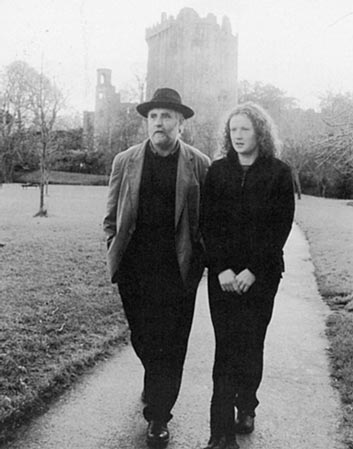
This Article From Issue
September-October 2001
Volume 89, Number 5
DOI: 10.1511/2001.34.0
In Code: A Mathematical Journey. Sarah Flannery with David Flannery. x + 341 pp. Workman Publishing, 2001. $24.95.
Teenagers are rarely expected to make important contributions to the scientific or technological world. So when 16-year-old Sarah Flannery developed a cryptography encryption algorithm that rivaled RSA (an established, standard system for encoding data), she ended up on the front page of the London Times. The media blitz that followed changed her life, and now she has written a book about the experience. In Code is an account of her life as both a celebrated young scientist and an everyday Irish teenager.

Photograph by Eddie O'Hare, from In Code.
Flannery, whose father is a mathematics professor, grew up in County Cork surrounded by math and computers. From a young age, she and her siblings worked problems on a chalkboard in the kitchen as dinner was prepared.
In high school, when she needed a project for a science competition, she naturally turned to her father. He suggested that she try programming some cryptography algorithms. Her original project consisted of making comprehensible to the public some previously existing algorithms—including RSA, the first public-key cryptosystem, which was developed at MIT in 1977 by Ronald Rivest, Adi Shamir and Leonard Adleman and has withstood all manner of attacks since then. The project was well done: At the Esat Young Scientist & Technology Exhibition, it won the Individual Intermediate Mathematics, Physics and Chemistry category that year (1998) and received the Intel Excellence Award (which made Flannery Ireland's representative at the Intel International Science and Engineering Fair). However, it was not innovative enough to win Ireland's Young Scientist of the Year competition.
To fulfill a school requirement designed to give students a taste of real-world work experience, Flannery arranged to spend a week at a cryptography company in Dublin. There she was given an unpublished paper written by the founder of the company, Michael Purser, and was asked to try to write code to implement his ideas. At her father's suggestion, she used matrices (an invention of the 19th-century mathematician Arthur Cayley) as a new setting for Purser's ideas and came up with what she called the Cayley-Purser, or CP, algorithm. This won her Young Scientist of the Year awards in both Ireland and Europe in 1999.
In Code is intended to be accessible to readers lacking a strong mathematical background. Flannery and her father (who, in order to speed the manuscript along, helped write the book's mathematical chapters) try to explain for a broad audience the mathematics behind encryption. This is commendable, and innovative. Unfortunately, the attempt meets with only partial success. They begin with straightforward mathematical definitions and work up to the basics of number theory, hoping to dispel readers' fear of math. However, this level of mathematics is too difficult to be simply read and understood, and despite their claim that "you shouldn't have to open another book to understand this one," readers would be better served by working through a textbook on number theory. Although the chapters on mathematics are placed in the middle of the book and interrupt the narrative, I would urge that readers at least skim them.
Being familiar with cryptography myself, I was interested in learning more about the CP algorithm and the theory behind it. Unfortunately, Flannery barely touches on her own discoveries, which are potentially the most interesting part of the book; instead, she devotes pages to explaining the standard RSA algorithm. This omission is both frustrating and mystifying.
In spite of these shortcomings, In Code is both inspiring and compelling. I especially enjoyed the mathematical puzzles that Flannery worked as a child. She does a good job of describing the difficulties of learning theoretical mathematics and programming algorithms, and she creates a rich picture of the tense environment surrounding science competitions. Flannery's passion for mathematics is apparent; however, in much of In Code, her rough prose is evidence of the difficulty in writing memoirs at the age of 18.—Kelle Love, high school senior, North Carolina School of Science and Mathematics, Durham
American Scientist Comments and Discussion
To discuss our articles or comment on them, please share them and tag American Scientist on social media platforms. Here are links to our profiles on Twitter, Facebook, and LinkedIn.
If we re-share your post, we will moderate comments/discussion following our comments policy.